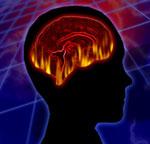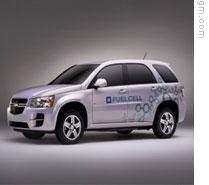VOA慢速英语 2008 1014b
时间:2019-01-11 作者:英语课 分类:VOA慢速英语2008(十)月
This is SCIENCE IN THE NEWS in VOA Special English. I'm Barbara Klein.
VOICE TWO:
And I'm Steve Ember. This week, we will tell about an American study of the brain disorder 1 schizophrenia. We tell about cars that use hydrogen as fuel. And, we will tell how one kind of tree deals with threats to its existence.
(MUSIC)
VOICE ONE:
 People who are schizophrenic sometimes hear voices or see things that are not real. They might believe other people want to hurt them. They can become fearful and socially withdrawn 2.
People who are schizophrenic sometimes hear voices or see things that are not real. They might believe other people want to hurt them. They can become fearful and socially withdrawn 2. America's National Institute of Mental Health describes schizophrenia as a brain disorder that is severe and disabling. It is also chronic 3, meaning long term.
The disorder usually appears in young men in their late teens or early twenties and in women in their twenties or thirties. Experts say it rarely appears in children. But when it does, it generally affects them more severely 4 than adults.
VOICE TWO:
Children with schizophrenia are often treated with "second-generation" antipsychotic drugs. But do these costly 5 newer drugs work better than older ones that cost less? The National Institute of Mental Health recently paid for a study by four universities in the United States. The research teams found that the answer was no.
They studied one hundred nineteen people between the ages of eight and nineteen. The patients were observed over an eight-week period. Some received two newer drugs: risperidone or olanzapine. Others received a first-generation antipsychotic drug, molindone.
VOICE ONE:
The study found that all of the patients experienced about the same improvement. But the risperidone and olanzapine caused serious weight gain. In fact, the institute cancelled the olanzapine research because the patients who took it gained an average of almost six kilograms. The concern was that the weight gain could lead to diabetes 6.
(MUSIC)
VOICE TWO:
For years, the automobile 7 industry has been testing vehicles that use hydrogen as fuel. Now, people across the United States have had a chance to see and even drive cars that get power from hydrogen fuel cells.

General Motors' Equinox fuel cell vehicle
The event was called Hydrogen Road Tour Oh-Eight. It took place earlier this year in thirty-one American cities. The road tour started in Maine and ended in southern California on August twenty-third.
Nine carmakers, two federal agencies and two other groups helped organize the event. It gave people interested in new technologies a chance to possibly experience the future of transportation.
VOICE ONE:
During the tour's stop in Washington, D.C., several hundred people gathered to test drive hydrogen powered cars. The cars look like other vehicles driven by millions of Americans everyday. But it is hydrogen, not more traditional fuels, that provides power for the cars.
Today's fuel cells represent huge steps forward in technology. But the hydrogen fuel cell is not a new idea. The fuel cell was invented by Sir William Grove 8 of Britain in eighteen thirty-nine. Since then, many different designs have been invented.
There is one place where fuel cells are a proven technology: in space. The American space agency used fuel cells in its Apollo spaceships in the twentieth century. And fuel cells provide all the electrical power for space shuttles.
VOICE TWO:
The most useful fuel cell for transportation purposes is the Polymer Electrolyte Membrane 9, or P.E.M., fuel cell. It is simple and can operate at temperatures of sixty to eighty degrees Celsius 10. That is much lower than other fuel cell designs.
A P.E.M. fuel cell has two sides separated by a thin substance or membrane. Hydrogen gas is forced through one side where it comes in contact with a reactive material containing the metal platinum 11.
The membrane separates the electrons from the protons in the hydrogen atoms. The protons pass through it to the other side of the fuel cell. But the electrons are captured to do work: like powering a motor.
Oxygen from the air is forced into the other side of the fuel cell. There, the gas meets the protons that have passed through the membrane. They combine to form water and heat.
VOICE ONE:
A single fuel cell does not produce a lot of electricity. But when many fuel cells are combined, they can produce enough electricity to power a vehicle. The product of the chemical reaction that powers fuel cells is water. This makes fuel cells a very clean technology.
But fuel cell cars have been slow to develop because of many technical problems that have to be solved. For example, it is unclear how long the membranes 12 in P.E.M. fuel cells will last.
Also, fuel cells need water for their chemical reactions. They must be designed to start easily in low temperatures and in dry climates. And smaller, less costly fuel cells must be designed before they can truly replace gasoline engines.
VOICE TWO:
The Hydrogen Road Tour Oh-Eight has shown the progress carmakers have made. BMW, Daimler, Ford 13, General Motors and Honda took part in the event. Also included were Hyundai-Kia, Nissan, Toyota and Volkswagen. Most of these companies already have hydrogen-powered models that are in use on roads today.
There are more models of fuel cell vehicles being tested than ever before. The threat of climate change and the high cost of oil has increased interest in these vehicles that do not cause pollution. But car buyers should not expect to see fuel cell cars at their local dealer 14 any time soon. Automakers say they will not build many fuel cell cars until hydrogen fueling and service stations are widely available. And that will cost billions of dollars and years of effort.
(MUSIC)
VOICE ONE:

A walnut 15 tree
Finally, American scientists have discovered that walnut trees can produce more than walnuts 16. The scientists say walnut trees also can make a chemical form of the popular pain-killing medicine aspirin 17. The trees do this under the stress, or pressure, of disease or other threats. Scientists say the chemical may help the trees reduce damage from dry weather, unseasonable temperatures and other changes in the environment.
VOICE TWO:
Thomas Karl reported the discovery. He works for the National Center for Atmospheric 18 Research, NCAR, in Boulder 19, Colorado. The National Science Foundation paid for the study. The results appeared recently in the publication Biogeosciences.
The results are important because presence of the chemical could warn growers early that a tree is in danger. Growers could recognize a problem before leaves on walnut trees die and fall off. The scientists said the findings also show that a plant can communicate with other plants through the atmosphere. For example, a tree could communicate when it is under attack from insects. With that information, a grower could begin corrective treatment.
VOICE ONE:
Researchers have known for a long time that laboratory plants may produce methyl salicylate, aspirin's chemical form. Aspirin was first produced from the bark covering on willow 20 trees. But the researchers had never before found methyl salicylate in a forest. They had not confirmed that trees could emit, or release, large amounts of the chemical into the atmosphere.
The American scientists discovered the chemical by accident. It happened after the NCAR team placed special measuring equipment in an area of walnut trees near Davis, California. The equipment was placed on structures about thirty meters above ground.
VOICE TWO:
The goal of the team was to observe some chemicals called volatile 21 organic compounds, or VOCs, that the trees emit. The organic compounds can influence climate and affect pollution. Mister Karl and his team were surprised to find that the emissions 22 of the VOCs contained methyl salicylate.
The scientists said a long period without rain had already affected 23 the trees. Then the stress increased. Leaf temperatures dropped to as low as about four and six-tenths degrees Celsius during the night. The cool conditions especially affected the trees when temperatures climbed quickly in the morning. The team said the change in temperature probably made the walnut tree react. The tree apparently 24 attempted to prevent freezing by emitting the chemical form of aspirin.
(MUSIC)
VOICE ONE:
This SCIENCE IN THE NEWS was written by Mario Ritter, Jerilyn Watson and Caty Weaver 25. Our producer was Brianna Blake. I'm Barbara Klein.
VOICE TWO:
And I'm Steve Ember. You can read and listen to our programs at voaspecialenglish.com. Join us next week for more news about science in VOA Special English.
- When returning back,he discovered the room to be in disorder.回家后,他发现屋子里乱七八糟。
- It contained a vast number of letters in great disorder.里面七零八落地装着许多信件。
- Our force has been withdrawn from the danger area.我们的军队已从危险地区撤出。
- All foreign troops should be withdrawn to their own countries.一切外国军队都应撤回本国去。
- Famine differs from chronic malnutrition.饥荒不同于慢性营养不良。
- Chronic poisoning may lead to death from inanition.慢性中毒也可能由虚弱导致死亡。
- He was severely criticized and removed from his post.他受到了严厉的批评并且被撤了职。
- He is severely put down for his careless work.他因工作上的粗心大意而受到了严厉的批评。
- It must be very costly to keep up a house like this.维修这么一幢房子一定很昂贵。
- This dictionary is very useful,only it is a bit costly.这本词典很有用,左不过贵了些。
- In case of diabetes, physicians advise against the use of sugar.对于糖尿病患者,医生告诫他们不要吃糖。
- Diabetes is caused by a fault in the insulin production of the body.糖尿病是由体內胰岛素分泌失调引起的。
- He is repairing the brake lever of an automobile.他正在修理汽车的刹车杆。
- The automobile slowed down to go around the curves in the road.汽车在路上转弯时放慢了速度。
- On top of the hill was a grove of tall trees.山顶上一片高大的树林。
- The scent of lemons filled the grove.柠檬香味充满了小树林。
- A vibrating membrane in the ear helps to convey sounds to the brain.耳膜的振动帮助声音传送到大脑。
- A plastic membrane serves as selective diffusion barrier.一层塑料薄膜起着选择性渗透屏障的作用。
- The temperature tonight will fall to seven degrees Celsius.今晚气温将下降到七摄氏度。
- The maximum temperature in July may be 36 degrees Celsius.七月份最高温度可能达到36摄氏度。
- I'll give her a platinum ring.我打算送给她一枚白金戒指。
- Platinum exceeds gold in value.白金的价值高于黄金。
- The waste material is placed in cells with permeable membranes. 废液置于有渗透膜的槽中。 来自辞典例句
- The sarcoplasmic reticulum is a system of intracellular membranes. 肌浆网属于细胞内膜系统。 来自辞典例句
- They were guarding the bridge,so we forded the river.他们驻守在那座桥上,所以我们只能涉水过河。
- If you decide to ford a stream,be extremely careful.如果已决定要涉过小溪,必须极度小心。
- The dealer spent hours bargaining for the painting.那个商人为购买那幅画花了几个小时讨价还价。
- The dealer reduced the price for cash down.这家商店对付现金的人减价优惠。
- Walnut is a local specialty here.核桃是此地的土特产。
- The stool comes in several sizes in walnut or mahogany.凳子有几种尺寸,材质分胡桃木和红木两种。
- Are there walnuts in this sauce? 这沙司里面有核桃吗?
- We ate eggs and bacon, pickled walnuts and cheese. 我们吃鸡蛋,火腿,腌胡桃仁和干酪。
- The aspirin seems to quiet the headache.阿司匹林似乎使头痛减轻了。
- She went into a chemist's and bought some aspirin.她进了一家药店,买了些阿司匹林。
- Sea surface temperatures and atmospheric circulation are strongly coupled.海洋表面温度与大气环流是密切相关的。
- Clouds return radiant energy to the surface primarily via the atmospheric window.云主要通过大气窗区向地表辐射能量。
- We all heaved together and removed the boulder.大家一齐用劲,把大石头搬开了。
- He stepped clear of the boulder.他从大石头后面走了出来。
- The river was sparsely lined with willow trees.河边疏疏落落有几棵柳树。
- The willow's shadow falls on the lake.垂柳的影子倒映在湖面上。
- With the markets being so volatile,investments are at great risk.由于市场那么变化不定,投资冒着很大的风险。
- His character was weak and volatile.他这个人意志薄弱,喜怒无常。
- Most scientists accept that climate change is linked to carbon emissions. 大多数科学家都相信气候变化与排放的含碳气体有关。
- Dangerous emissions radiate from plutonium. 危险的辐射物从钚放散出来。
- She showed an affected interest in our subject.她假装对我们的课题感到兴趣。
- His manners are affected.他的态度不自然。
- An apparently blind alley leads suddenly into an open space.山穷水尽,豁然开朗。
- He was apparently much surprised at the news.他对那个消息显然感到十分惊异。